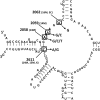Mycoplasma pneumoniae: Current Knowledge on Macrolide Resistance and Treatment
- PMID: 27446015
- PMCID: PMC4916212
- DOI: 10.3389/fmicb.2016.00974
Mycoplasma pneumoniae: Current Knowledge on Macrolide Resistance and Treatment
Abstract
Mycoplasma pneumoniae causes community-acquired respiratory tract infections, particularly in school-aged children and young adults. These infections occur both endemically and epidemically worldwide. M. pneumoniae lacks cell wall and is subsequently resistant to beta-lactams and to all antimicrobials targeting the cell wall. This mycoplasma is intrinsically susceptible to macrolides and related antibiotics, to tetracyclines and to fluoroquinolones. Macrolides and related antibiotics are the first-line treatment of M. pneumoniae respiratory tract infections mainly because of their low MIC against the bacteria, their low toxicity and the absence of contraindication in young children. The newer macrolides are now the preferred agents with a 7-to-14 day course of oral clarithromycin or a 5-day course of oral azithromycin for treatment of community-acquired pneumonia due to M. pneumoniae, according to the different guidelines worldwide. However, macrolide resistance has been spreading for 15 years worldwide, with prevalence now ranging between 0 and 15% in Europe and the USA, approximately 30% in Israel and up to 90-100% in Asia. This resistance is associated with point mutations in the peptidyl-transferase loop of the 23S rRNA and leads to high-level resistance to macrolides. Macrolide resistance-associated mutations can be detected using several molecular methods applicable directly from respiratory specimens. Because this resistance has clinical outcomes such as longer duration of fever, cough and hospital stay, alternative antibiotic treatment can be required, including tetracyclines such as doxycycline and minocycline or fluoroquinolones, primarily levofloxacin, during 7-14 days, even though fluoroquinolones and tetracyclines are contraindicated in all children and in children < 8 year-old, respectively. Acquired resistance to tetracyclines and fluoroquinolones has never been reported in M. pneumoniae clinical isolates but reduced susceptibility was reported in in vitro selected mutants. This article focuses on M. pneumoniae antibiotic susceptibility and on the development and the evolution of acquired resistance. Molecular detection of resistant mutants and therapeutic options in case of macrolide resistance will also be assessed.
Keywords: Mycoplasma pneumoniae; macrolides; molecular detection; resistance; treatment.
Figures

References
-
- Akaike H., Miyashita N., Kubo M., Kawai Y., Tanaka T., Ogita S., et al. . (2012). In vitro activities of 11 antimicrobial agents against macrolide-resistant Mycoplasma pneumoniae isolates from pediatric patients: results from a multicenter surveillance study. Jpn. J. Infect. Dis. 65, 535–538. 10.7883/yoken.65.535 - DOI - PubMed
Publication types
LinkOut - more resources
Full Text Sources
Other Literature Sources

